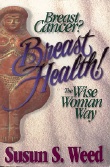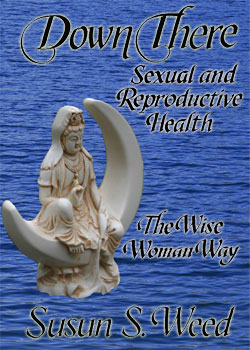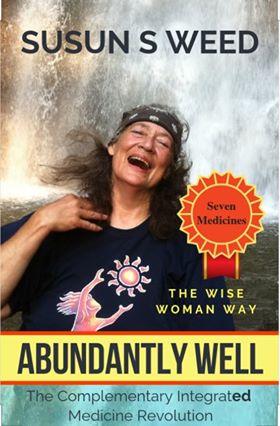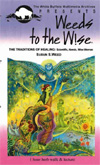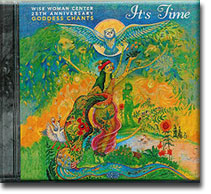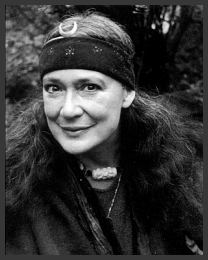www.susunweed.com
Herbal Adventures with Susun S Weed
Brassicaceae family 'aka' Cruciferae (crucifix) family
as seen printed in www.sagewoman.com
Herbal medicine is people's medicine; herbal medicine is women's medicine. Most women alive today, everywhere across this planet, rely on local herbs to keep themselves and their families well. A basic knowledge of herbal medicine helps women -- such as you -- stay free from dependence on drugs and doctors, and gives women -- such as you -- the ability to acquire simple effective remedies at little or no cost.
You don't have to be an expert to use herbs as medicine. You don't even need to know how to read or write. You can learn as our foremothers did: by breathing in what the plant gives you and breathing out to the plant, and by allowing Nature to school you through day dreams and night visions, trance journeys and spontaneous understandings, by means of taste, touch, smell, and sight, and through the songs of the plants.
But we live in a fast world, and learning from Nature is a slow process. Want a shortcut? Learn a little botany! Botany is a superhighway that optimizes your ability to understand plants and use them wisely So let's continue our tour of some of my favorite plant families. I'd like to introduce you to the cabbage, or mustard, family.
The cabbage family always makes me smile. It is easy to recognize and most of its members are delicious to eat. That's reason enough to be delighted, but it gets even better. Some cabbage family plants are strongly medicinal, and all of them can prevent cancer.
The cabbage/mustard family used to be known as the Cruciferae (crucifix) family, because their flowers have four petals arranged in the shape of a cross. But now we call it the Brassicaceae family, in honor of its most edible genus: Brassica. (See sidebar.)
In addition to four petals -- which are usually colored white, yellow, or pink -- plants in the Brassicaceae family have four sepals (green parts that protect the flower bud). There are six pollen-producing stamen in each flower: four tall and two short. The female part (the pistil) has a two-chambered ovary which produces seeds in a conspicuous, often upright, seed pod.
Lunaria, or silver dollar plant -- an old favorite for the flower garden -- is a Brassicaceae that's grown not for its leaves or flowers (which are a beautiful shade of dark pink), but for its large, showy, silvery, round membranes: the divider that separated the two chambers of the seed pod. Queen of the Night is another flower garden Brassicaceae; its tall stalks of purple, pink, and white flowers have a swooningly wonderful smell in the evening. It is visited by the hummingbird moth, a sight never to be forgotten. Lucky me; it's a wildflower where I live. Wallflowers, another old favorite, also in the cabbage family, are prized for their boldly-colored flowers and ease of cultivation.
All species of the cabbage family are very easy to grow, in fact; they need only cool soil to germinate in. Even poor, dry, clayey soils can produce big crops of Brassicaceae plants. Humans have been cultivating the Brassicaceae for such a long time (several thousand years at least), that we have created an enormous number of plants that look different, but are, in reality, just different forms of cabbage.
In previous columns we learned that each and every plant, indeed each thing in nature, has its own specific (species) name. So it is likely to surprise you, maybe even cause you to wrinkle your brow, when I tell you that kale, collards, brussels sprouts, broccoli, cauliflower, kohlrabi, and all cultivated cabbages including red cabbage, white cabbage, savoy cabbage, and "flowering" cabbage are all Brassica oleracea. And although they have different species names now, turnips and rutabagas were once considered Brassica oleracea too. See why this family makes me smile? It's full of pleasant surprises.
The Brassicaceae also make the Chinese smile; they grow thousands of varieties of edible cabbage family greens including bok choy, Chinese cabbage, pak choi, chicli, shungiku, wong bok, pe tsai, and many others. And they, like Europeans, rely on Brassicaceae roots -- turnips, swedes, and the many varieties of radish -- to bulk out their diet.
The Japanese grow and enjoy Brassicaceae roots, too, especially those -- such as daikon and wasabi -- that pack a spicy punch. Europeans and Americans like spicy mustard family plants too, like mustard greens and horseradish, but when they want a "breath of fire" to liven up their weiners or hot dogs, they go for Brassicaceae seeds, not roots, and grind them into familiar yellow "mustard." Mustard plasters -- a mixture of finely-ground mustard seeds, wheat flour and water -- were a favorite folk remedy in the pioneer days, but may blister the skin if left on too long.
Oil can be pressed from mustard seeds, but it is generally poisonous. But rape (pronounced "rah-pay"), a type of mustard seed, was modified to produce an edible oil known as canola oil. Mustard seed oil is the basis of mustard gas, a vicious chemical used in World War One (which caused blistering and burning of the skin and lungs), and the progenitor of today's anti-cancer chemotherapeutic agents.
Yes, the Brassicaceae family is accepted by orthodox and alternative practitioners alike as an important anti-cancer and cancer-preventative ally. Four servings a week of cabbage family plants reduce overall risk of cancer by half. That makes me grin. What fun; how easy; and how kind to the budget. The cabbage family offers us a different cooked* green for every night of the week and then some, including the darling of high society: watercress. Its botanical name -- Nasturtium officinale -- is rather confusing; watercress is not even related to garden nasturtium, Trapaeolum majus.
Herbalists rejoice when they see shepherd's purse, or, as one of my students prefers to call it, shaman's pouch. This small cabbage family plant packs a big wallop when tinctured. I harvest the above-ground parts of the plant -- including leaves, stalks, seed pods and flowers -- and tincture it in 100 proof vodka for six weeks to make a remedy that slows and stops menstrual, menopausal, and post-partum hemorrhages. Midwives tell me that a dropperful under the tongue can stop profuse bleeding in seconds.
Are you smiling yet? You will be if this introduction encourages you to get chummy with the delicious, useful, friendly Brassicaceae family! I'll be back in the next issue to share more fun with plant families.
* It isn't wise to eat cabbage family plants such as broccoli, cauliflower, kale, collards, and cabbage raw or lightly-steamed. They interfere with iodine uptake and contribute to thyroid malfunction by lowering the rate at which it produces hormones.
Some Medicinal and Edible Brassicaceae
Armoracea lapathifolia: Horseradish (counters sinus problems, gum disease; diuretic)
Brassica chinensis: Chinese cabbage
Brassica napus var napobrassica: Rutabaga, Swede
Brassica nigra: Black mustard (seed plaster counters lung congestion, joint pain)
Brassica oleracea var acephala: Kale, Collards (counters cancer; builds bones)
Brassica oleracea var botrytis: Cauliflower (counter colon cancer)
Brassica oleracea var italica: Broccoli (counters cervical, colon, lung cancers)
Brassica oleracea var gemmifera: Brussels sprouts (counters cancer)
Brassica oleracea: Cabbage (protects against radiation; juice heals ulcers, acne, colds)
Brassica oleracea rubra: Red cabbage (counters cancer, lowers cholesterol)
Brassica rapa: Turnip, Field mustard, Broccoli di rappe (counters cancer)
Brassica sylvestris: Wild cabbage
Barbarea vulgaris: St. Barbara's cress, Yellow rocket (wound healer)
Capsella bursa-pastoris: Shepherd's purse (anti-hemmoragic)
Cheiranthus cheiri: Wallflower (emmenagogue, cardiac stimulant, nervine)
Dentaria diphylla: Toothwort
Eruca sativa: Arugula, Rocket
Hesperis matronalis: Dame's rocket; Queen of the Night (diuretic, diaphoretic, expectorant)
Lepidium sativum: Garden cress
Lepidium virginicum: Poor person's pepper
Nasturtium officinale: Watercress (aphrodisiac, contraceptive, laxative, nervine)
Sinapis alba: Yellow mustard (plaster counters chronic pain)
Sisymbrium officinale: Singer's Rocket, Hedge mustard (counters laryngitis, colds, canker sores)
Dear Susun,
I hope you don't mind my writing to you. I am filled with anxiety all the time, about everything. I'm afraid to be alone, but more afraid to be with anyone else. I'm worried that I will say the wrong thing or do the wrong thing. I know I must be eating the wrong things, but I can't seem to figure out what I should eat. I'm scared that I'll get cancer, or be in a terrible accident. Sometimes I can't sleep what with all the fearful things going on in my imagination. Is there anything I can do to feel a little better?
Adrianna from Atlanta
Dear Adrianna,
Yes, the world is a scary place, and more so for women. There are terrors lurking in our minds and in reality. But fear freezes us; it doesn't make us safer. Here's what I do to be at ease in an uneasy world.
First, I drink oatstraw infusion (Avena sativa), at least two quarts a week. This strengthens and tonifies the nervous system, calms the mind, and soothes hyperactive nerves. To make it: Put one ounce of dried oatstraw (by weight) in a quart jar; fill to the top with boiling water. Put on a tight lid and let it steep for at least four hours. Then strain the liquid from the herb, squeezing well, and drink hot with honey or over ice. Refrigerate what you don't drink, but do consume it within the next twenty-four hours.
Second, I invite my friend motherwort (Leonurus cardiaca) to go everywhere with me. A daily dose of a dropperful of tincture made from the fresh flowering plant, taken morning and night, provides a strong, secure emotional base. A dose of 5-20 drops, taken as needed, brings calm to overheated and supercharged situations. I find it exceptionally useful to help me calm down when nothing has happened yet but my imagination is doing its best to scare me senseless.
Third, I turn my anxiety into anger. Anger gives me energy to take care of myself so my anxious fantasies don't come true. Anger give me energy to work toward changing the things that scare me, particularly violence against women. Anger burns away my anxiety and frees the Amazon inside every woman. Yes, it is a little scary to be angry, but you have nothing to lose since you are anxious anyway. Give it a try. Scare your fears away!Green blessings. Susun
Susun Weed
PO Box 64
Woodstock, NY 12498
Vibrant, passionate, and involved, Susun Weed has garnered an international reputation for her groundbreaking lectures, teachings, and writings on health and nutrition. She challenges conventional medical approaches with humor, insight, and her vast encyclopedic knowledge of herbal medicine. Unabashedly pro-woman, her animated and enthusiastic lectures are engaging and often profoundly provocative.
Susun is one of America's best-known authorities on herbal medicine and natural approaches to women's health. Her four best-selling books are recommended by expert herbalists and well-known physicians and are used and cherished by millions of women around the world. Learn more at www.susunweed.com
For permission to reprint this article, contact us at: www.ashtreepublishing.com/contact
Visit Susun Weed at: www.susunweed.com and www.wisewomanbookshop.com
Susun Weed’s books include:
Wise Woman Herbal for the Childbearing Year
Author: Susun S. Weed.
Simple, safe remedies for pregnancy, childbirth, lactation, and newborns. Includes herbs for fertility and birth control. Foreword by Jeannine Parvati Baker. 196 pages, index, illustrations.
Order at: www.wisewomanbookshop.com
Healing Wise
Author: Susun S. Weed.
Superb herbal in the feminine-intuitive mode. Complete instructions for using common plants for food, beauty, medicine, and longevity. Introduction by Jean Houston. 312 pages, index, illustrations.
Order at: www.wisewomanbookshop.com

NEW Menopausal Years the Wise Woman Way
Author: Susun S. Weed.
The best book on menopause is now better. Completely revised with 100 new pages. All the remedies women know and trust plus hundreds of new ones. New sections on thyroid health, fibromyalgia, hairy problems, male menopause, and herbs for women taking hormones. Recommended by Susan Love MD and Christiane Northrup MD. Introduction by Juliette de Bairacli Levy. 304 pages, index, illustrations.
Order at: www.wisewomanbookshop.com
For excerpts visit: www.menopause-metamorphosis.com
Breast Cancer? Breast Health!
Author: Susun S. Weed.
Foods, exercises, and attitudes to keep your breasts healthy. Supportive complimentary medicines to ease side-effects of surgery, radiation, chemotherapy, or tamoxifen. Foreword by Christiane Northrup, M.D. 380 pages, index, illustrations.
Order at: www.wisewomanbookshop.com
Down There: Sexual and Reproductive Health the Wise Woman Way
Publication date: June 21, 2011
Author: Susun S. Weed
Simple, successful, strategies cover the entire range of options -- from mainstream to radical -- to help you choose the best, and the safest, ways to optimize sexual and reproductive health. Foreword: Aviva Romm, MD, midwife, 484 pages, Index, illustrations.
Order at: www.wisewomanbookshop.com
Abundantly Well - Seven Medicines The Complementary Integrated Medical Revolution
Publication date: December 2019
Author: Susun S. Weed
Seven Medicines build foundational health and guide you to the best health care when problems arise. Includes case studies, recipes, exentsive references and resources. Introduction by Patch Adams illustrated by Durga Yael Bernhard 352 pages, index, illustrations
Order at: www.wisewomanbookshop.com
Susun Weed's Video & CD's:Weeds to the Wise DVD Video
Visit Susun's farm for a weed walk. Hear her talk on the Three Traditions of Healing. Make infusion with her. Fun! (1 hour VHS video) Please note: this VHS video tape is in NTSC format which may not be compatible with video players outside of the USA and Canada.
Order at: www.wisewomanbookshop.com
Susun Weed's "It's Time"
Wise Woman Center
25th Anniversary Celebration CD
GODDESS CHANTS CD
Visit www.goddesschants.com to hear all the songs, read lyrics &
learn about the artists.
18 Wise Woman Songs & Chants from the heart
For Wholesale orders see our terms letter or contact us at:
Ash Tree Publishing PO Box 64 Woodstock, NY 12498 ~
Website: www.wisewomanbookshop.com ~
Susun Weed, green witch and wise woman, is an extraordinary teacher with a joyous spirit, a powerful presence, and an encyclopedic knowledge of herbs and health. She is the voice of the Wise Woman Way, where common weeds, simple ceremony, and compassionate listening support and nourish health/wholeness/holiness. She has opened hearts to the magic and medicine of the green nations for three decades. Ms. Weed's Six herbal medicine books focus on women's health topics including: menopause, childbearing, and breast health. Visit her site www.susunweed.com for information on her workshops, apprenticeships, correspondence courses and more! Venture into the Menopause site www.menopause-metamorphosis.com to learn all about the Menopausal Years the Wise Woman Way.
Join Susuns Mentorship site for personal one on one mentorship! We also invite you to visit our commerce site www.wisewomanbookshop.com to learn about our Wise Woman publications, workshops, correspondence courses. As well as online courses at Wise Woman School.
back to articles index
back to press kit
© Susun Weed -Wise Woman Center
~ Disclaimer & Privacy Policy ~


